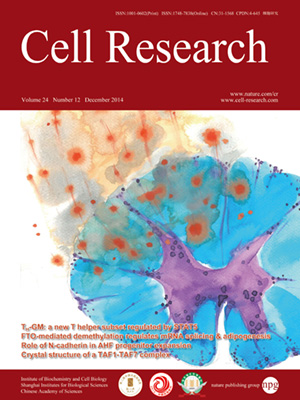
Volume 24, No 12, Dec 2014
ISSN: 1001-0602
EISSN: 1748-7838 2018
impact factor 17.848*
(Clarivate Analytics, 2019)
Volume 24 Issue 12, December 2014: 1387-1402 | Open Access
ORIGINAL ARTICLES
STAT5 programs a distinct subset of GM-CSF-producing T helper cells that is essential for autoimmune neuroinflammation
Wanqiang Sheng1,2, Fan Yang1, Yi Zhou3, Henry Yang1, Pey Yng Low4, David Michael Kemeny4, Patrick Tan1,5, Akira Moh7, Mark H Kaplan7,8, Yongliang Zhang4 and Xin-Yuan Fu1,3,6,8
1Cancer Science Institute of Singapore, YLL School of Medicine, National University of Singapore, Singapore
2Department of Biological Sciences, Faculty of Science, National University of Singapore, Singapore
3Department of Biochemistry, YLL School of Medicine, National University of Singapore, Singapore
4Immunology Programme and Department of Microbiology, YLL School of Medicine, National University of Singapore, Singapore
5Cancer and Stem Cell Biology, Duke-NUS Graduate Medical School, Singapore
6Neurobiology Programme, Life Sciences Institute, National University of Singapore, Singapore
7Departments of Pediatrics and Herman B Wells Center for Pediatric Research, Indiana University School of Medicine, Indianapolis, IN 46202, USA
8Department of Microbiology and Immunology, Indiana University School of Medicine, Indianapolis, IN 46202, USA
Correspondence: Yongliang Zhang, E-mail: miczy@nus.edu.sg; Xin-Yuan Fu,(xin-yuan_fu@nuhs.edu.sg)
T helper (TH)-cell subsets, such as TH1 and TH17, mediate inflammation in both peripheral tissues and central nervous system. Here we show that STAT5 is required for T helper-cell pathogenicity in autoimmune neuroinflammation but not in experimental colitis. Although STAT5 promotes regulatory T cell generation and immune suppression, loss of STAT5 in CD4+ T cells resulted in diminished development of experimental autoimmune encephalomyelitis (EAE), a mouse model of multiple sclerosis. Our results showed that loss of encephalitogenic activity of STAT5-deficient autoreactive CD4+ T cells was independent of IFN-γ or interleukin 17 (IL-17) production, but was due to the impaired expression of granulocyte-macrophage colony-stimulating factor (GM-CSF), a crucial mediator of T-cell pathogenicity. We further showed that IL-7-activated STAT5 promotes the generation of GM-CSF-producing CD4+ T cells, which were preferentially able to induce more severe EAE than TH17 or TH1 cells. Consistent with GM-CSF-producing cells being a distinct subset of TH cells, the differentiation program of these cells was distinct from that of TH17 or TH1 cells. We further found that IL-3 was secreted in a similar pattern as GM-CSF in this subset of TH cells. In conclusion, the IL-7-STAT5 axis promotes the generation of GM-CSF/IL-3-producing TH cells. These cells display a distinct transcriptional profile and may represent a novel subset of T helper cells which we designate as TH-GM.
10.1038/cr.2014.154
FULL TEXT | PDF
Browse 2490


